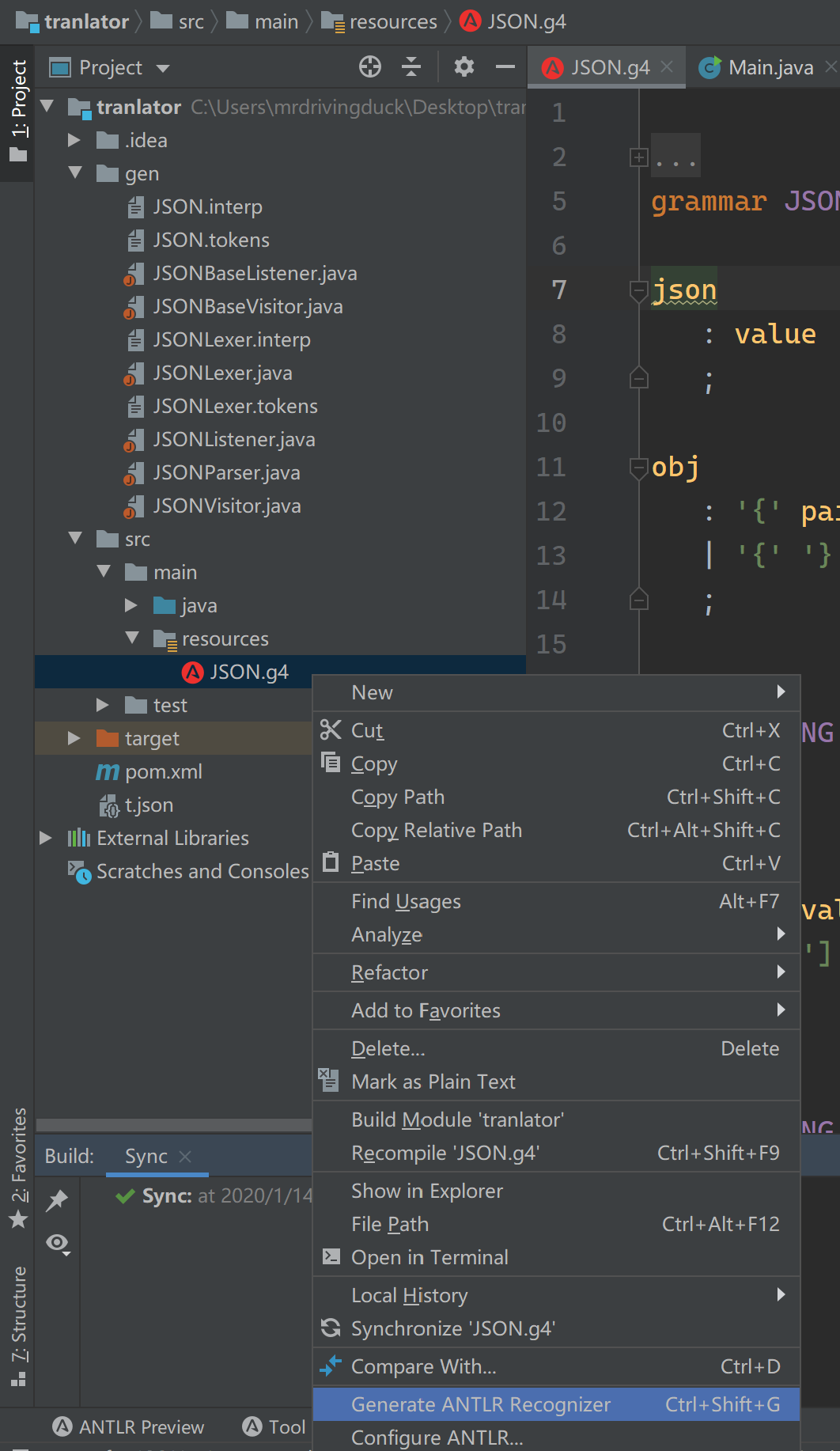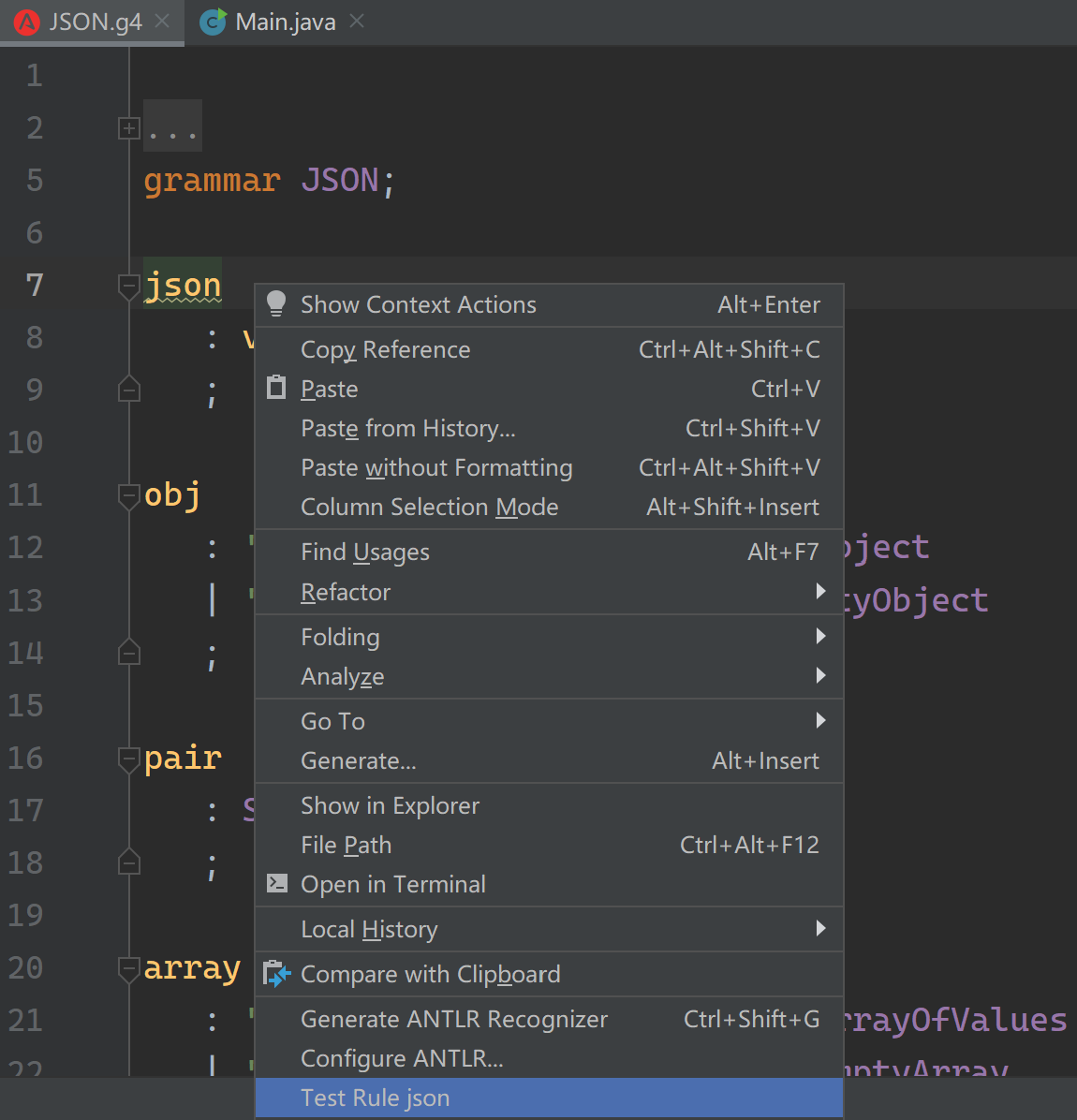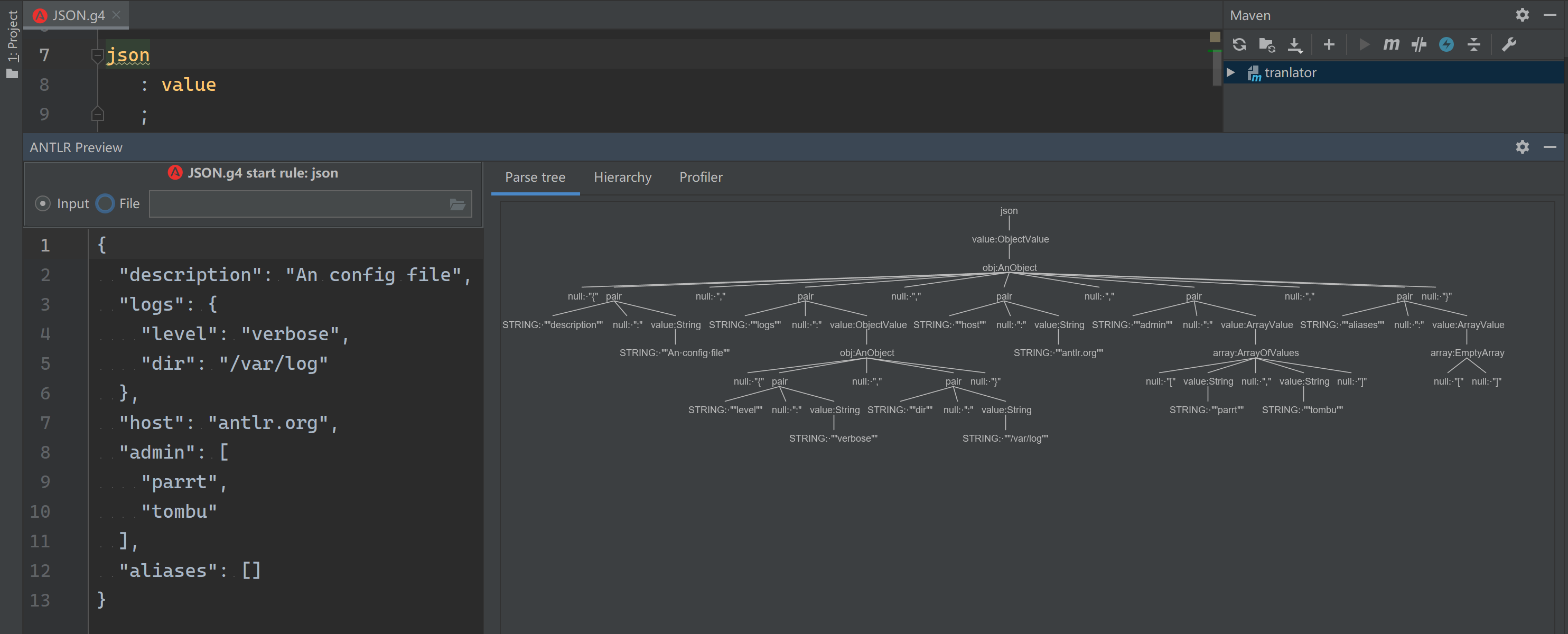ANTLR - Basic
Created by : Mr Dk.
2020 / 01 / 14 17:25
Nanjing, Jiangsu, China
ANTLR (ANother Tool for Language Recognition) 是一套计算机语言处理框架,可用于对特定语法的语言进行词法分析、语法分析、语法树构建。最新的 ANTLR v4 规定了一套 g4 语法。g4 语法可以针对对象语言进行类似 巴克斯范式 (Backus-Naur From, BNF) 的描述。ANTLR 可以将 g4 语法文件直接转换为词法分析和语法分析的 Java 代码 (或其它实现语言),这样就可以得到一个 Java 实现的语言识别器,比如:
- SQL 识别器
- JSON 识别器
除了用于自动生成 Java 代码,ANTLR 还提供一个 Runtime 工具,用于为自动生成的 Java 代码的执行提供支持。Runtime 需要作为依赖 (如 Maven) 引入。对于流行通用的编程语言、格式,开源社区都已经提供了 现成的 g4 语法文件 🤞
本文以生成一个 Java 版本的 JSON 解析器作为 🌰。
Example
以下是 grammars-v4 中提供的 JSON 语法文件 JSON.g4
/** Taken from "The Definitive ANTLR 4 Reference" by Terence Parr */
// Derived from http://json.org
grammar JSON;
json
: value
;
obj
: '{' pair (',' pair)* '}'
| '{' '}'
;
pair
: STRING ':' value
;
array
: '[' value (',' value)* ']'
| '[' ']'
;
value
: STRING
| NUMBER
| obj
| array
| 'true'
| 'false'
| 'null'
;
STRING
: '"' (ESC | SAFECODEPOINT)* '"'
;
fragment ESC
: '\\' (["\\/bfnrt] | UNICODE)
;
fragment UNICODE
: 'u' HEX HEX HEX HEX
;
fragment HEX
: [0-9a-fA-F]
;
fragment SAFECODEPOINT
: ~ ["\\\u0000-\u001F]
;
NUMBER
: '-'? INT ('.' [0-9] +)? EXP?
;
fragment INT
: '0' | [1-9] [0-9]*
;
// no leading zeros
fragment EXP
: [Ee] [+\-]? INT
;
// \- since - means "range" inside [...]
WS
: [ \t\n\r] + -> skip
;
有了这个文件,可以借助 ANTLR 的工具直接生成识别 JSON 的 Java 代码。
ANTLR 提供命令行版本的工具,但更方便的还是集成在 IDEA 中的插件:

对语法文件进行 Generate ANTLR Recognizer 后,可以看到自动生成了一些文件。其中核心的文件是:
JSONLexer.java:词法分析代码JSONParser.java:语法分析代码
生成的其它的文件接下来再作解释。接下来,在项目中引入 ANTLR Runtime 依赖。由 ANTLR Runtime 支持,这些类就可以被实例化了:
public static void main(String[] args) {
CharStream input = CharStreams.fromString("{}");
JSONLexer lexer = new JSONLexer(input);
CommonTokenStream tokens = new CommonTokenStream(lexer);
JSONParser parser = new JSONParser(tokens);
}
运行该程序,可以看到指定的输入是否可以被该识别器所接受。
此外,插件还带有语法树预览的功能,在语法文件的 top-level rule (顶层语法规则) 右击 Test Rule <rule_name>:

从文本框或文件接收测试输入后,就能看到预览的 AST:

Listener && Visitor
使用 ANTLR 框架的更多需求是,当进入或退出某条语法规则的时候,我们可能想做一些事情,比如在 AST 上做一定的转换。ANTLR 允许我们在语法树上注册回调函数,并提供了两种遍历方式 - listener 和 visitor。
Listener
使用 ANTLR 的代码生成工具,得到了一个 JSONListener.java。这是一个接口文件,里面定义了 进入 和 退出 每一条语法规则的函数:
public interface JSONListener extends ParseTreeListener {
/**
* Enter a parse tree produced by {@link JSONParser#json}.
* @param ctx the parse tree
*/
void enterJson(JSONParser.JsonContext ctx);
/**
* Exit a parse tree produced by {@link JSONParser#json}.
* @param ctx the parse tree
*/
void exitJson(JSONParser.JsonContext ctx);
/**
* Enter a parse tree produced by the {@code AnObject}
* labeled alternative in {@link JSONParser#obj}.
* @param ctx the parse tree
*/
void enterAnObject(JSONParser.AnObjectContext ctx);
/**
* Exit a parse tree produced by the {@code AnObject}
* labeled alternative in {@link JSONParser#obj}.
* @param ctx the parse tree
*/
void exitAnObject(JSONParser.AnObjectContext ctx);
// ...
}
实际上内部继承了 ANTLR Runtime 的 ParseTreeListener 类。在大部分情况下,我们只希望指定某几个规则的行为,其它的什么也不做。
ANTLR 已经自动生成了一个 JSONBaseListener.java,该类实现了上述接口中定义的每一个 enter / exit 函数,但每个函数的实现都是空的。我们只需新建一个继承自 JSONBaseListener 的 Class,并只需要 override 我们想要操作的那几条规则对应的函数即可。
- 如果 override
enter函数,则是一种先序遍历的逻辑 - 如果 override
exit函数,则是一种后序遍历的逻辑
遍历的具体过程:
- 遍历到一个结点时,自动调用
enter函数 - 自动遍历所有的子结点
- 子结点遍历完毕后,自动调用
exit函数
在遍历到某一结点时,可以通过参数中的 context 取得结点上的信息。
遍历的基本代码如下:
// 用之前实例化的 parser,实例化从顶层规则开始的语法树 (json 是顶层规则)
ParseTree tree = parser.json();
// 实例化一个 listener
JSON2XML.XMLEmitter listener = new JSON2XML.XMLEmitter();
// 实例化 walker
ParseTreeWalker walker = new ParseTreeWalker();
// 通过 walker,向语法树上注册 listener 并遍历
walker.walk(listener, tree);
Visitor
ANTLR 的代码生成工具也自动生成了一个 JSONVisitor.java。这个文件也是一个接口,里面定义了访问到每一条语法规则对应结点的函数:
public interface JSONVisitor<T> extends ParseTreeVisitor<T> {
/**
* Visit a parse tree produced by {@link JSONParser#json}.
* @param ctx the parse tree
* @return the visitor result
*/
T visitJson(JSONParser.JsonContext ctx);
/**
* Visit a parse tree produced by the {@code AnObject}
* labeled alternative in {@link JSONParser#obj}.
* @param ctx the parse tree
* @return the visitor result
*/
T visitAnObject(JSONParser.AnObjectContext ctx);
// ...
}
与 listener 的区别在于,visit 函数在访问到某个结点时被触发。如果还想继续访问子结点,需要显式调用 visitChild() 函数。否则,遍历深度就在该结点中止。
同样,代码生成工具生成了 JSONBaseVisitor.java,该类实现了接口中定义的所有函数,并在每个函数中默认调用了 visitChild() 函数以继续进行遍历:
/**
* {@inheritDoc}
*
* <p>The default implementation returns the result of calling
* {@link #visitChildren} on {@code ctx}.</p>
*/
@Override public T visitJson(JSONParser.JsonContext ctx) { return visitChildren(ctx); }
如果需要自定义实现逻辑,只需新建一个继承自 JSONBaseVisitor 的 Class,并 override 对应函数即可:
JSONBaseVisitor visitor = new JSONBaseVisitor();
visitor.visit(tree); // 实例化 visitor,并 visit 语法树
Label
对于某一条语法规则,如果想生成更加细粒度的函数进行分别处理该怎么做?
比如,对于 JSON 中 value 的取值:
value
: STRING
| NUMBER
| obj
| array
| 'true'
| 'false'
| 'null'
;
想对数字 (NUMBER)、布尔值 (true / false)、空值 (null) 作特殊处理,而对其它的不作。按照默认的模式,应当只会生成 enterValue() / exitValue() / visitValue(),无法满足这一需求。那么可以在语法文件中加入 label,细化要产生的函数:
value
: STRING # String
| NUMBER # Atom
| obj # ObjectValue
| array # ArrayValue
| 'true' # Atom
| 'false' # Atom
| 'null' # Atom
;
注意,label 在一条规则中要么全加,要么全不加
然后重新使用 ANTLR 的代码生成工具,可以看到额外产生了四组函数:
enterString()/exitString()/visitString()enterObjectValue()/exitObjectValue()/visitObjectValue()enterArrayValue()/exitArrayValue()/visitArrayValue()enterAtom()/exitAtom()/visitAtom()
这样,就可以按类别分别实现自定义操作了。
Case-Insensitive Lexing
对于 SQL 等一些 (关键字以外) 大小写不敏感的语言的处理方式:
Summary
这套工具由旧金山大学的 Terence Parr 教授开发。我本人很佩服这套框架的定位:类似于 LLVM 编译器的前后端解耦,ANTLR 实现了语法和应用逻辑的解耦,使我们在大部分应用场景下,不用太关心语法的具体细节,不再需要专门实现语法的解析逻辑,因为 ANTLR 帮我们完成了最复杂的 语法 → 应用程序 的自动转换。(实际上也就是词法、语法分析代码的自动生成)
此外,具体的语法细节由相关方面的专家代为完成,有了这套框架,开发与语言相关的应用将更为容易。